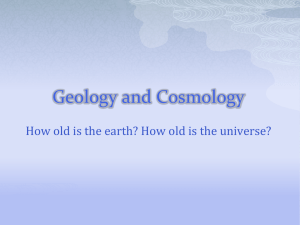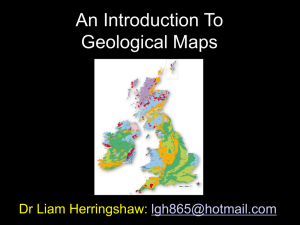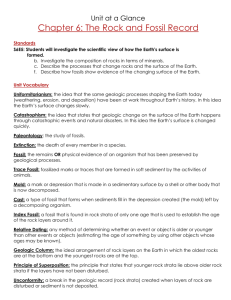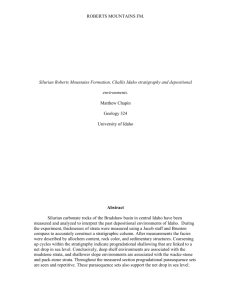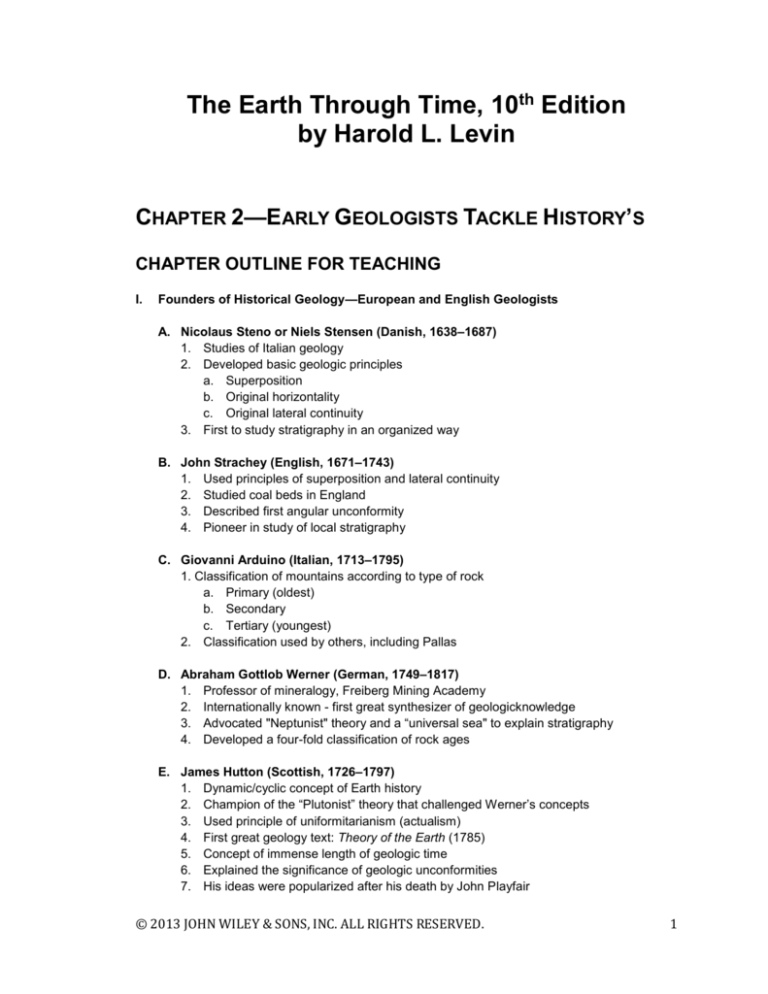
The Earth Through Time, 10th Edition
by Harold L. Levin
CHAPTER 2—EARLY GEOLOGISTS TACKLE HISTORY’S
CHAPTER OUTLINE FOR TEACHING
I.
Founders of Historical Geology—European and English Geologists
A. Nicolaus Steno or Niels Stensen (Danish, 1638–1687)
1. Studies of Italian geology
2. Developed basic geologic principles
a. Superposition
b. Original horizontality
c. Original lateral continuity
3. First to study stratigraphy in an organized way
B. John Strachey (English, 1671–1743)
1. Used principles of superposition and lateral continuity
2. Studied coal beds in England
3. Described first angular unconformity
4. Pioneer in study of local stratigraphy
C. Giovanni Arduino (Italian, 1713–1795)
1. Classification of mountains according to type of rock
a. Primary (oldest)
b. Secondary
c. Tertiary (youngest)
2. Classification used by others, including Pallas
D. Abraham Gottlob Werner (German, 1749–1817)
1. Professor of mineralogy, Freiberg Mining Academy
2. Internationally known - first great synthesizer of geologicknowledge
3. Advocated "Neptunist" theory and a “universal sea" to explain stratigraphy
4. Developed a four-fold classification of rock ages
E. James Hutton (Scottish, 1726–1797)
1. Dynamic/cyclic concept of Earth history
2. Champion of the “Plutonist” theory that challenged Werner’s concepts
3. Used principle of uniformitarianism (actualism)
4. First great geology text: Theory of the Earth (1785)
5. Concept of immense length of geologic time
6. Explained the significance of geologic unconformities
7. His ideas were popularized after his death by John Playfair
© 2013 JOHN WILEY & SONS, INC. ALL RIGHTS RESERVED.
1
F. William Smith (English, 1769–1839)
1. Civil engineer and surveyor for coal company
2. Recorded detail of stratigraphy in Britain and Wales
3. First to publish a geologic map (1815)
4. Noted fossil succession in stratigraphy; his book was titled Strata Identified by
Organized Fossils
5. Principle of fossil succession
6. His observations were used extensively by later workers: Lyell and Darwin; Is
considered the “father of English geology”
G. George Léopold Cuvier (French, 1769–1832)
1. Validated Smith's observations on fossil succession
2. Attributed unconformities to catastrophes
3. Advocated ‘catastrophism’ as a view of Earth history
4. Advocated young age for Earth
H. Charles Lyell (English, 1797–1875)
1. Advocate and author exposing views of ancient Earth history and uniformitarianism
2. Author of important text: Principles of Geology (1830)
3. Synthesizer of stratigraphy who developed the first geologic time scale
4. Principles of cross-cutting relationships and inclusions
5. Developed concept of relative age dating and sequence of events
I.
Charles Darwin (English, 1809–1882)
1. Learned geology in the field from Adam Sedgwick, a prominent geology of the day at
Cambridge University
2. Read and embraced Lyell’s Principles of Geology
3. Learned much about geology and biology on five year voyage of the H.M.S. Beagle
(1831-1836)
4. Wrote a general theory of evolution to account for fossil succession; proposed natural
selection theory
5. Reviewed the work of Wallace, who had similar findings
6. Author of several key books, including Origin of Species (1859)
II. Founders of Historical Geology—American Geologists
A. Louis Agassiz (1807–1873)
1. Swiss immigrant to U.S. in 1846; Harvard professor
2. In Studies of Glaciers (1840), proposed that immense ice sheets once covered North
America
3. Studied glacial striations, erratics, and moraines
4. Wrote about the “Ice Age,” which ended about 8,000 to 10,000 years ago
B. James Hall (1811–1898)
1. Director of New York’s first Geologic Survey
2. Studied over 40,000 feet of strata in New York
3. First to theorize about the subsidence of the seafloor and its effect on stratal
accumulation
4. Author of The Paleontology of New York
© 2013 JOHN WILEY & SONS, INC. ALL RIGHTS RESERVED.
2
3
C. Ferdinand V. Hayden (1829–1887)
1. Studied the badlands of South Dakota and the Black Hills
2. Lobbied for creation of Yellowstone Park
3. Conducted geologic surveys of western territories
D. John Powell (1834–1902)
1. Director of geological surveys of the western territories
2. Director, U.S. Geological Survey
3. Pioneer explorer of the Colorado River
E. Othniel C. Marsh (1831–1899)
1. Professor of paleontology at Yale
2. Founded Peabody Museum of Natural History
3. Led famous dinosaur explorations of the western U.S.
F. Edwin D. Cope (1850–1897)
1. Well-known fossil expert at the University of Pennsylvania
2. Led famous dinosaur explorations of the western U.S.
3. Bitter rival of Marsh in the “dinosaur rush”
Answers to Discussion Questions
1. Steno’s principles were superposition, initial horizontality, and original lateral continuity.
Mainly the first and third principles of Steno were used by William Smith, who intuitively
rediscovered them. Where Smith studied the succession of strata, he used superposition.
Where Smith traced or correlated layers, he used the principle of original lateral continuity.
2. One reason that the fossils would differ is that if the layers are different ages, organic
evolution would have produced a different fauna or flora entombed in the respective rock
formations. Another reason is that the layers may have been formed under different
environmental conditions and therefore the fauna or flora living where the rock formed would be
different for environmental reasons.
3. Steno reasoned that sedimentary layers form from settling of particles and that typically forms
a horizontal layer. Thus, he said that all sedimentary layers are initially horizontal. If such layers
are found in any position other than horizontal, they must have been changed since deposition by
geologic forces. If older strata are found on top of younger strata, this violates Steno’s principle
of superposition, which says that younger always occurs on top of older. The logical conclusion
is that the strata were overturned (turned upside down) by geologic forces.
4. In observing this cross-cutting relationship, Hutton might have looked for evidence that the
heat of the igneous rock affected the minerals in the adjacent sedimentary rock or melted some of
the sedimentary rock.
© 2013 JOHN WILEY & SONS, INC. ALL RIGHTS RESERVED.
3
5. These are the proper matches.
John Powell – Explorer of Grand Canyon
Charles Lyell – Cross-cutting relationships
Abraham Werner – Pioneer mineralogist and Neptunist
Georges Cuvier – Proponent of catastrophism
Louis Agassiz – Recognition of Ice Age
William Smith –
James Hutton – Uniformitarianism
Charles Darwin – Natural selection
Nicholas Steno – Original horizontality
James Hall – From depositional basins to mountains
Othniel Marsh – Fossil vertebrates of western U.S.
6. The “cross sections” will show the following:
a.
b.
c.
d.
e.
Flat-lying Silurian strata on the seafloor.
Silurian strata being squeezed and tilted upward by compression.
Near vertical Silurian strata being eroded to a nearly flat surface.
Devonian strata being deposited horizontally over the Silurian erosional surface.
Silurian and overlying Devonian strata being tilted by compression.
7. The only way to explain having 40,000 feet of sedimentary rock that showed evidence of only
forming in shallow water was to have the basin in which these layers accumulated subside slowly
over time.
8. According to the principle of cross-cutting relationships, the previously molten rock must be
younger to have cut across older, therefore pre-existing rock.
CHAPTER ACTIVITIES
Student activities for in-depth learning
1. Recently (2009), Charles Darwin’s 200th birthday passed and so did the 150th anniversary of
the publication of his masterwork, Origin of Species. Learn more about Darwin by visiting this
extensive page on his life and work: AboutDarwin.com (http://www.aboutdarwin.com/index.html).
Read about his voyage on the Beagle and write an account of the places visited on the voyage
(see the “Timeline” section of AboutDarwin.com). Also comment on how these sorts of
observations may have profoundly influenced the way of thinking of Darwin after he returned from
the voyage.
2. The paleontological “bone wars” of Cope and Marsh are legendary. Using the web, (for
example - http://www.wyomingtalesandtrails.com/bonewars2.html) read more about the battles
between these two dinosaur hunters of the past. Write a short summary of what they were
competing over, who they were, and make a list of their separate and joint finds and discoveries.
© 2013 JOHN WILEY & SONS, INC. ALL RIGHTS RESERVED.
4




